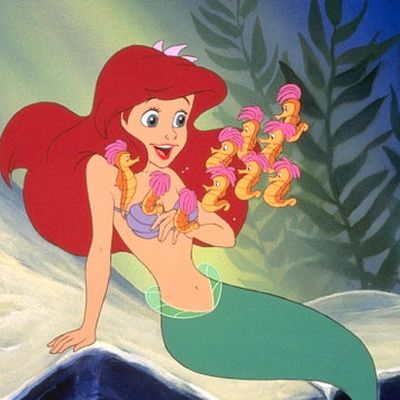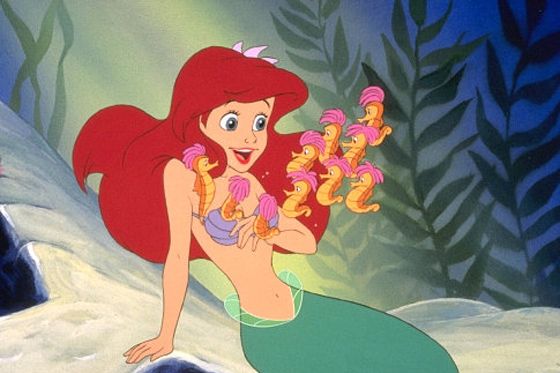

The Nostalgia Fact-Check is a recurring Vulture feature in which we revisit a seminal movie, TV show, or album that reflexively evinces an “Oh my God, that was the best ever!” response by a certain demographic, owing to it having been imprinted on them early. Now, years later, we will take a look at these classics in a more objective, unforgiving adult light: Are they really the best ever? How do they hold up now? We’ve already reconsidered Heathers, Ally McBeal, Ace of Base’s The Sign, Ghostbusters, and Dinosaurs. Our latest installment: Disney’s The Little Mermaid.
Background: When The Little Mermaid was released in 1989, Disney’s storied animation department had been on a three-decade skid. Since 1961’s One Hundred and One Dalmatians, the company had put out a string of lackluster films that, by the late eighties, almost amounted to an abandonment of the genre. The Little Mermaid changed all that. Heralded as a return to form, the film, with its catchy soundtrack, adorable sea creatures, and spunky heroine, made over $210 million worldwide and kicked off the Disney renaissance (so real it has a Wikipedia page!), a creative period in children’s entertainment matched only by Disney’s productivity in the late thirties and early forties (when Disney released Snow White, Pinocchio, Fantasia, Dumbo, and Bambi) and Pixar’s still-ongoing run. Disney built on Mermaid’s success by using the same creative team and formula for 1991’s Beauty and the Beast, the first animated movie ever to be nominated for an Academy Award for Best Picture, and 1992’s Aladdin. All three films (unlike 1994’s The Lion King, the high watermark of this period for Disney) are love stories based on previously existing fairy tales that feature future members of the powerful merchandising force known as the Disney Princesses, and they have music and lyrics from Alan Menken and Howard Ashman.
Nostalgia Demo: Anyone 12 and under or not yet born in 1989; the parents of the aforementioned demographics may have fond feelings for these films as well.
Nostalgia Fact-Check: “Look at this stuff” is a fairly common phrase in spoken American English. It is also the first line of “Part of Your World,” one of the songs in The Little Mermaid. As a result, it is a fairly common occurrence that when I — an adult who, prior to this week, had not watched The Little Mermaid for at least fifteen years — hear someone say “Look at this stuff,” I still instantly get “Part of Your World” stuck in my head. (The only other words that trigger a song in my mind quite as consistently are “I have shit to do,” which, mortifyingly and unfortunately, causes me to reflexively recall an Ani DiFranco spoken-word poem about abortion. Obviously, I never should have moved on from Disney films.) Say other words from “Part of Your World” — “gizmos, thingamabobs, ‘no big deal,’” or “what’s that word again” — and it’s 50-50 that the same thing will happen. I’m not alone. Every single woman I told of my plans to rewatch The Little Mermaid almost immediately serenaded me with this song, in full command of the lyrics and vocal inflections: Turns out, it’s not that easy to hit the high note on “I waaant mooore.”
Needless to say, of the three Disney movies that came out in my tween years, the one nearest and dearest to my heart, the one I listened to endlessly on a white plastic cassette tape, was The Little Mermaid. I loved Aladdin — my class sang “A Whole New World” for sixth-grade graduation (it beat out “Wind Beneath My Wings”) — and I didn’t mind Beauty and the Beast, but The Little Mermaid was my favorite. Given my deep fondness for this movie, and particularly its soundtrack, I was not at all concerned about fact-checking it. I was sure it would hold up. I was wrong. The Little Mermaid is a bore.
The Little Mermaid is directly responsible for a pop-culture universe that takes animated movies seriously. It didn’t just raise the bar: Coming after thirty years of stasis, it was a reminder that a bar even existed. The Little Mermaid encouraged thousands of creative people to invest in making children’s movies, and those people, being good at their jobs, went out and made The Little Mermaid look really old-fashioned. Kids and grown-ups saw Ariel, and like her, they wanted more: Belle, Simba, Mulan, Buzz Lightyear, Wall-E, and, next year, another redhead who wants to stand on her own two — whaddya call ‘em — feet are just some of the results. If you want to pay your respects to The Little Mermaid watch any of those films instead.
Most Disney movies, not to mention fairy tales, are about princesses and their princes. While there is certainly a feminist critique to be done of The Little Mermaid, my concerns are, in this instance, purely entertainment based. The issue is not that Ariel falls in love, the issue is that the movie slows to a crawl when she does. This is in part because “Kiss the Girl” is the only good song left in the film — all due respect to “Le Poissson” (which is striking for clearly having been conceived in a world with very few vegetarians) — and in part because, well, the heroine can’t speak anymore. This messes up the love story irrevocably. Falling in love is portrayed in compelling ways in both Beauty and the Beast and Aladdin, which are better than The Little Mermaid in almost every way, and not just because Disney made glorious strides in animation in only two short years. Belle and Aladdin, blessed with the ability to talk to their heart’s desires, are both fully fleshed-out characters who fall for fully fleshed-out characters. We know why Belle and the Beast and Aladdin and Jasmine like each other. Why do Ariel and Eric like each other? Because they find the other one … pretty? Because Eric has a nice dog? How can they get to know each other, or the audience get to know Eric, when they can’t even have a conversation? The character development screeches to a halt, and Flounder’s annoyingly cutesy act isn’t enough to make up for it. In a post Finding Nemo world, it’s hard not to imagine that there are far more interesting adventures a mermaid might have than falling in love with a Ken doll.
Horrible realization: In the second half of The Little Mermaid, Ariel becomes the Bella Swan of the Disney Princess set. Having spied her “soul mate” Ariel hands her life over to the evil, awesomely campy Ursula and the gruff, well-meaning Sebastian turns monosyllabic, and then survives because of her father and her boyfriend’s timely interventions. Just like the Twilight protagonist, she even ends up changing species. Also! Ariel gets obsessed with a big marble statue of Eric, “marble” being Bella’s favorite word for describing Edward’s physique.
The only two things about The Little Mermaid that really held up — and they’re not small — are Ursula, who is a spectacular, creepy, commanding villain (and what is she, exactly? A mer-octopus? An octo-maid?), and the songs, which remain great even though “Part of Your World” does not sound quite as epic in the film as it does in my imagination/karaoke sessions, thanks to some relatively spare instrumentation. Though some have read “Under the Sea” as racist — because it’s about all these fish, who are coded as black, celebrating their laziness — the actual number is so the opposite of lazy, and Sebastian is so by far the most serious, focused character in the film, that it wouldn’t have occurred to me if the meme wasn’t already out there.
What’s most striking about The Little Mermaid now is that it’s a kids’ movie, but from a time before studios were even aware that parents would have to watch these things too. There’s a shark chase that comes in the first ten minutes of the film that has no real tension and a bunch of animated slapstick, but it would sure make a 6-year-old laugh. Just two years later, Disney would learn to pay attention to the grown-ups. The problems of The Little Mermaid, both narrative and visual, are wholly resolved in Beauty and the Beast. That film is a excellent example of taking a thing that wasn’t broken (Little Mermaid did, after all, make a ton of money and get great reviews) and fixing it anyway. The soundtrack may not be as good (“Human Again”?), but all of the characterization problems in the Little Mermaid evaporate. The people are nuanced and complex, the relationships have heft, the camera work suddenly contains 360 shots and wide angles, the story never lags, and Belle, a weirdo who wants to be left alone to read her books, will beat up wolves with whatever weapons she has at hand: Belle is no Bella Swan. Appealing to the adults was taken even further in Aladdin, which zips along with more energy than Beauty, but also made pop-culture references and the celebrity voice-overs a de facto component of animated films. Robin Williams does do an amazing if frenetic job as the genie, and the movie doesn’t suffer for it, but if you want to know why Rodney Dangerfield and Jack Nicholson impressions are popping up in films for tykes, there’s only Aladdin to blame.
The Little Mermaid is directly responsible for a pop-culture universe that takes animated movies seriously. It didn’t just raise the bar: Coming after thirty years of stasis, it was a reminder that a bar even existed. The Little Mermaid encouraged thousands of creative people to invest in making children’s movies, and those people, being good at their jobs, went out and made The Little Mermaid look really old-fashioned. Kids and grown-ups saw Ariel, and like her, they wanted more: Belle, Simba, Mulan, Buzz Lightyear, Wall-E, and, next year, another redhead who wants to stand on her own two — whaddya call ‘em — feet are just some of the results. If you want to pay your respects to The Little Mermaid watch any of those films instead.

